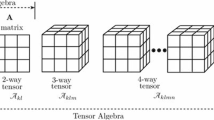Abstract
The palmprint recognition methods can be categorized as the feature-based methods and the appearance-based methods. The conventional appearance-based representation methods merely express the test sample as a weighting sum of training samples and exploit the deviation between the test sample and the weighting sum of the training samples from each class for classification. In this paper we exploited an appearance-based palmprint recognition method called bidirectional representation method based pattern classification (BRBPC) on palmprint recognition. The BRBPC algorithm not only used the training samples to express the test sample, but also take into account the expression of the test sample to the training sample. Experiments on PolyU multi-spectral palmprint database and 2D and 3D palmprint database show that the proposed method outperforms the conventional appearance-based palmprint recognition methods.









Similar content being viewed by others
References
Cook T, Sutton R, Buckley K (2010) Automated flexion crease identification using internal image seams. Pattern Recogn 43:630–635
Cui JR (2012) Bidirectional representation for face recognition across pose. Neural Comput Appl pp 1–6
Gan J, Zhou D (2006) A novel method for palmprint recognition based on wavelet transform. Signal Processiong, 2006 8th International Conference on. IEEE. 3
PolyU multispectral palmprint Database. http://www.comp.polyu.edu.hk/~biometrics/MultispectralPalmprint/MSP.html
Hu D, Feng G, Zhou Z (2007) Two-dimensional locality preserving projections (2DLPP) with its application to palmprint recognition. Pattern Recogn 40(1):339–342
Huang DS, Jia W, Zhang D (2008) Palmprint verification based on principal lines. Pattern Recogn 41(4):1316–1328
Jia W, Huang D, Zhang D (2008) Palmprint verification based on robust line orientation code. Pattern Recogn 41(5):1504–1513
Kong AK, Zhang D (2004) Competitive coding scheme for palmprint verification. ICPR 2004 1:520–523
Kong A, Zhang D, Kamel M (2006) Palmprint identification using feature-level fusion. Pattern Recogn 39(3):478–487
Kong WK, Zhang D, Li W (2003) Palmprint feature extraction using 2-D Gabor filters. Pattern Recogn 36(10):2339–2347
Leng L, Zhang JS, Khan MK, Chen X, Alghathbar K (2010) Dynamic weighted discrimination power analysis: a novel approach for face and palmprint recognition in DCT domain. Int J Phys Sci 5(17):2543–2554
Leng L, Zhang JS, Xu JG, Khan MK, Alghathbar K (2010) Dynamic weighted discrimination power analysis in DCT domain for face and palmprint recognition. International Conference on Information and Communication Technology Convergence (ICTC), 467–471
Li M, Yuan B (2005) 2D-LDA: a statistical linear discriminant analysis for image matrix. Pattern Recogn Lett 26(5):527–532. doi:10.1016/j.patrec.2004.09.007
Li W et al (2011) 3-D palmprint recognition with joint line and orientation features. IEEE Trans Syst Man Cybern C Appl Rev 41(2):274–279
Lu J, Tan YP (2009) Two-directional two-dimensional discriminant locality preserving projections for image recognition. ICASSP 2009:1753–1756
Lu J, Tan YP (2011) Improved discriminant locality preserving projections for face and palmprint recognition. Neurocomputing 74(18):3760–3767
Lu G, Zhang D, Wang K (2003) Palmprint recognition using Eigenpalm features. Pattern Recogn Lett 24(9):1463–1467
Naseem I, Togneri R, Bennamoun M (2010) Linear regression for face recognition. IEEE Trans Pattern Anal Mach Intell 32(11):2106–2112
Sang H, Yuan W, Zhang Z (2009) Research of palmprint recognition based on 2DPCA. In: Proc. 6th international Symp. on Neural Networks. Springer Verlag, Heidelberg, pp 831–838
Wang X et al (2006) Palmprint identification using boosting local binary pattern. In 18th Int. Conf. on Pattern Recognition, IEEE Computer Society, Piscataway, pp. 503–506
Wright J et al (2009) Robust face recognition via sparse representation. IEEE Trans Pattern Anal Mach Intell 31(2):210–227
Wu X, Zhang D, Wang K (2003) Fisherpalms based palmprint recognition. Pattern Recogn Lett 24(15):2829–2838. doi:10.1016/S0167-8655(03)00141-7
Xu Y, Fan Z, Zhu Q (2012) Feature space-based human face image representation and recognition. Opt Eng 51(1):017205
Xu Y, Yang JY, Jin Z (2004) A novel method for fisher discriminant analysis. Pattern Recogn 37(2):381–384
Xu Y, Zhang D, Yang J-Y (2010) A feature extraction method for use with bimodal biometrics. Pattern Recogn 43(3):1106–1115
Xu Y, Zhang D, Yang J, Yang J-Y (2011) A two-phase test sample sparse representation method for use with face recognition. IEEE Trans Circ Syst Video Technol 21(9):1255–1262
Xu Y, Zhong A, Yang J, Zhang D (2011) Bimodal biometrics based on a representation and recognition approach. Opt Eng 50(3):037202
Yang J et al (2004) Two-dimensional PCA: a new approach to appearance-based face representation and recognition. IEEE Trans Pattern Anal 36(1):131–137
Yu P, Jie W (2010) An improved method of palmprint recognition based on independent component analysis. J Guangdong Univ Technol 1:014
Zhang D, Kong WK, You J, Wong M (2003) Online palmprint identification. IEEE Trans Pattern Anal Mach Intell 25(9):1041–1050. doi:10.1109/TPAMI.2003.1227981
Zhang D, Shu W (1999) Two novel characteristics in palmprint verification: datum point invariance and line feature matching. Pattern Recogn 34(4):691–702
Zhang L, Yang M, Feng X (2011) Sparse representation or collaborative representation: which helps face recognition? IEEE int. Conf. on Computer vision, IEEE Computer Society, Piscataway, pp 471–478
Zhang L, Zhang D (2004) Characterization of palmprints by wavelet signatures via directional context modeling. IEEE Trans Syst Man Cybern B Cybern 34(3):1335–1347
Zuo W et al. (2010) The multiscale competitive code via sparse representation for palmprint verification. IEEE Conf. on Computer Vision and Pattern Recognition, IEEE Computer Society, Piscataway. pp 2265–2272
Author information
Authors and Affiliations
Corresponding author
Rights and permissions
About this article
Cite this article
Cui, J., Wen, J. & Fan, Z. Appearance-based bidirectional representation for palmprint recognition. Multimed Tools Appl 74, 10989–11001 (2015). https://doi.org/10.1007/s11042-014-1887-4
Published:
Issue Date:
DOI: https://doi.org/10.1007/s11042-014-1887-4




